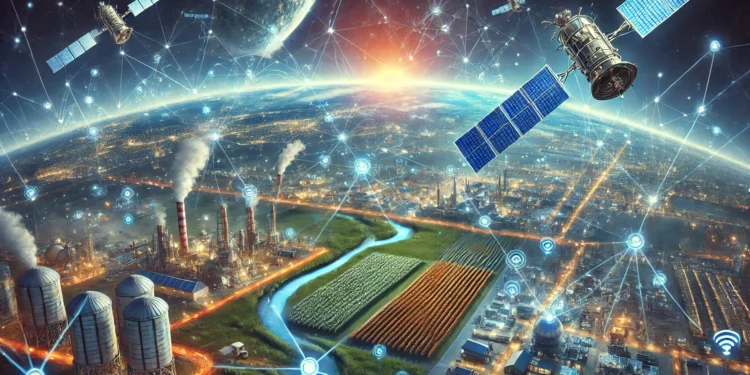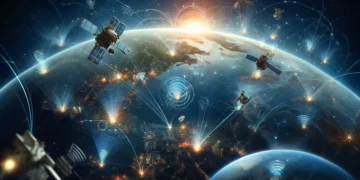We would all likely like to wake up in a world where roads inform of traffic buildup, bridges portray signs of stress, and an entire city operates based on data. Thanks to the integration of IoT in infrastructure management, this vision is transforming into reality. Increases in connected technologies are driving developments in infrastructure management so that such features can be monitored for potential issues, maintained proactively, and integrated within systems.
In this informative article, we will discuss how IoT is reshaping infrastructure management, the use of satellite technology, and satellite IoT solutions, especially in outer and densely populated areas.
Role of IoT in Infrastructure Management
In the past, infrastructure maintenance involved ad hoc surveys, inspection reports, and response-based maintenance. However, the Internet of Things (IoT) is changing this area. IoT encompasses the use of sensors, devices, and networks to continuously control and enhance infrastructure systems.
Critical Benefits of IoT in Infrastructure Management:
- IoT allows infrastructure conditions to be updated in real-time, thus making it easier to make intelligent decisions while minimizing risks.
- One can anticipate failures beforehand, thus avoiding them and reducing additional costs.
- Smart systems use energy for purposeful use rather than waste for sustainable energy utilization.
- IoT satellite communication facilitates secure connectivity in hard-to-reach areas.
Therefore, IoT plays a crucial role in enhancing the management of infrastructures in a way that is more proactive, efficient, and sensitive to the current and emerging demands in complex urban and other remote areas.
IoT and Satellite Technology: A Perfect Partnership
However, to realize the full potential of IoT in infrastructure management, it will have to be connected. Satellite systems have a very significant function in providing solutions to connectivity challenges, particularly in inaccessible regions.
Why Satellite Technology Matters
- Provides Global Coverage: Satellite networks make it possible to have a continuous network connection around the world, and no infrastructure is left unsurveyed.
- Reliable Performance: Satellites work well within worse weather and harsh geography.
- Seamless Integration: IoT satellite communication can be comfortably incorporated into conventional systems, making them very solid.
In this way, satellite technology provides IoT devices with constant connectivity, thereby ensuring that the operations in critical infrastructure systems remain intact.
IoT Satellite Solutions for Infrastructure Management
Satellite IoT solutions are already paving the way forward for infrastructure refurbishment. These solutions harness satellites’ capability to connect IoT devices in even the most challenging settings: highways, railways, and power and water supply networks.
Applications of Satellite IoT Solutions
Smart Transportation:
Real-time observation of the condition of roads and traffic flow.
Facilitating effective interaction between connected cars will decrease the number of accidents and traffic jams.
Structural Health Monitoring:
Monitoring stress and strain of load-bearing steel structures like bridges, dams, and buildings.
Employing the IoT satellite communication for real-time structural updates regarding their performance.
Energy Infrastructure:
Supervise the power grids and pipelines to note any trends hindering efficiency and safety.
Implement satellite IoT solutions to identify deviations and avoid shutdowns.
Environmental Monitoring:
Measuring which weather conditions are favorable for plant growth, the type of soil required, and the type of water best suited for irrigation.
Using satellite facilities to gather credible real-time features of the environment.
The Role of IoT Satellite Companies
Satellite IoT companies are today spearheading innovation in infrastructure management solutions that cater to their specific needs. These companies allow organizations to implement fault-tolerant, secure, and efficient IoT platforms with satellite connectivity.
How IoT Satellite Companies Are Shaping the Future:
- They build IoT systems for transportation, energy, and environmental control and develop IoT applications for significant structures and infrastructures.
- These companies use AI and machine learning features to access and pass on actionable information.
- Business people can lease private satellite networks that will meet their communication needs without much interference.
Connectivity with Satellite Networks
While terrestrial networks can be particularly important for maintaining communication in developed areas, satellite networks may be crucial for other regions as they are the only way to connect barely accessible areas.
Key Advantages of Satellite Networks:
- Uninterrupted Communication: They provide continuity of the cellular signals and may be used in areas where cellular signals cannot be received.
- Scalability: Satellite networks are also flexible for growth to meet increasing infrastructure requirements.
- Cost-Effectiveness: With constant growth in satellite technologies, expenses are coming down, and therefore, satellite IoT solutions are feasible.
It is clear that industries can realize optimized and connected infrastructure regarding geographical hurdles by adopting IoT and strong satellite networks.
The Future of IoT in Infrastructure Management
This is just the starting point of how IoT and satellite technology will be combined in the future. This area will continue to grow, and therefore, in the near future, there will be unprecedented changes in the manner by which infrastructure is observed and controlled.
Emerging Trends to Watch:
- Low Earth Orbit (LEO) Satellites: These satellites help decrease the delay and thus enhance the rate of communication to the extent of real-time decision-making.
- AI-Powered IoT Systems: According to the information, AI improves the efficiency of predictive maintenance and resource management.
- Energy-Efficient Satellites: Green satellite solutions are embraced in the formulation of space-based solutions to fulfill sustainability objectives while offering superior performance.
That said, the future of IoT in infrastructure management is promising, and advancements continue to be made to make the impossible possible.
IoT in Infrastructure Management for Remote Industries
For industries located in geographical areas that are not easily accessible, such as mining, agriculture, and energy, the amalgamation of IoT and satellite is unbeatable.
Applications in Remote Industries:
- Manage and monitor machinery, vehicles, and other equipment during their operations.
- Synchronize private satellite networks to allow interconnectivity between remote work teams.
- Monitor changes in the weather and natural conditions to be safe and productive.
These applications underscore the application value proposition of satellite IoT solutions in revolutionizing operational efficiency and safety for industries in remote regions.
Final Word
The introduction of IoT technology in infrastructure management is innovative and changing the way physical structures and systems are monitored, maintained, and optimized. Enabling smart traffic and electricity grids, pollution tendency monitoring and habitat monitoring is opening the way to the future.
Focusing on IoT satellite companies, improving satellite networks, and the emergence of private satellite network industries can eliminate the problems concerning uneven connections and reveal the potential of IoT.
With new technological improvements, more interaction between IoT and satellite solutions will be an excellent way to enhance futuristic infrastructure systems worldwide.
The view to the future is only to explore the opportunities brought by IoT and satellite technology for managing infrastructure and creating a connected, intelligent, and sustainable world.













